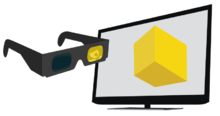

An active shutter 3D system (a.k.a. alternate frame sequencing, alternate image, AI, alternating field, field sequential or eclipse method) is a technique of displaying stereoscopic 3D images. It works by only presenting the image intended for the left eye while blocking the right eye's view, then presenting the right-eye image while blocking the left eye, and repeating this so rapidly that the interruptions do not interfere with the perceived fusion of the two images into a single 3D image.
Modern active shutter 3D systems generally use liquid crystal shutter glasses (also called "LC shutter glasses"[1] or "active shutter glasses"[2]). Each eye's glass contains a liquid crystal layer which has the property of becoming opaque when voltage is applied, being otherwise transparent. The glasses are controlled by a timing signal that allows the glasses to alternately block one eye, and then the other, in synchronization with the refresh rate of the screen. The timing synchronization to the video equipment may be achieved via a wired signal, or wirelessly by either an infrared or radio frequency (e.g. Bluetooth, DLP link) transmitter. Historic systems also used spinning discs, for example the Teleview system.
Active shutter 3D systems are used to present 3D films in some theaters, and they can be used to present 3D images on CRT, plasma, LCD, projectors and other types of video displays.
- ^ "LC shutter glasses provide 3-D display for simulated flight", Information Display Magazine, Vol. 2, Issue 9, September 1986
- ^ "Active Shutter 3D Technology for HDTV", PhysOrg, September 25, 2009